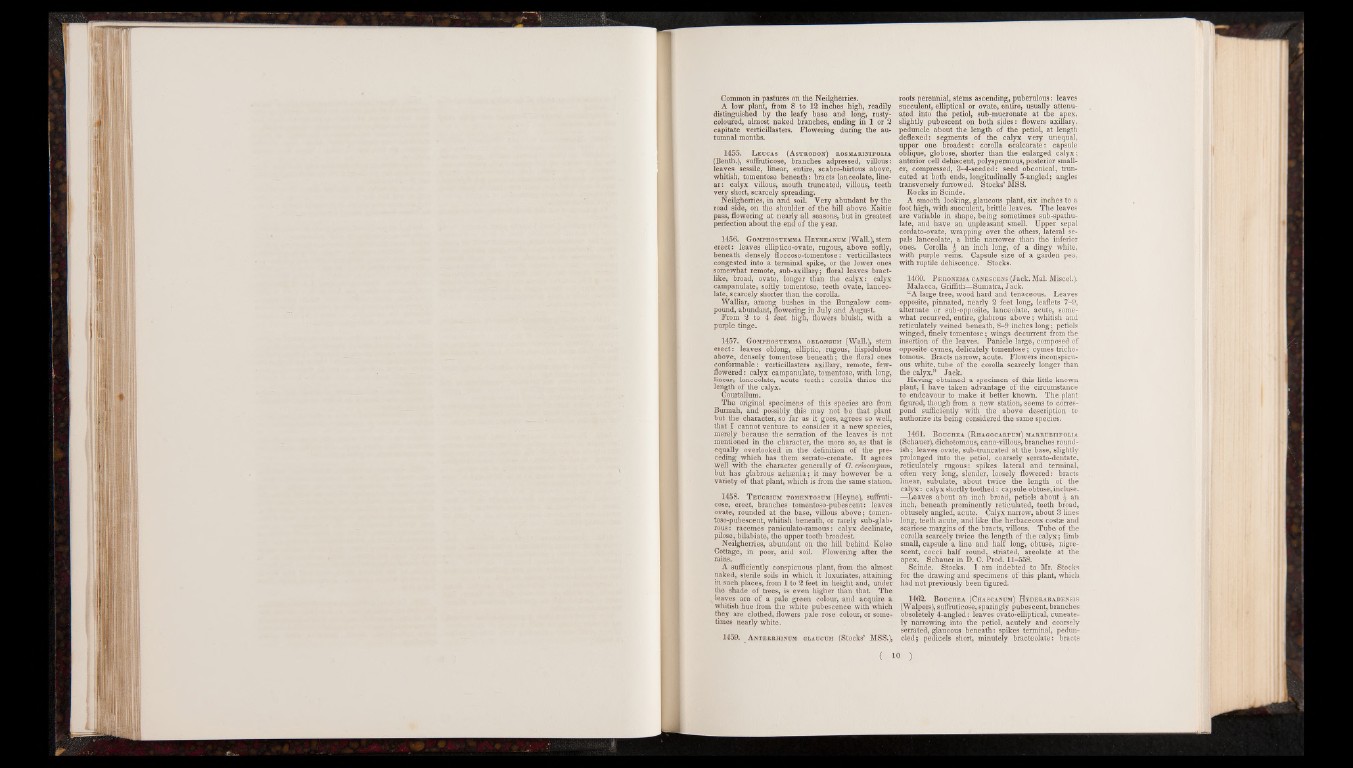
Common in pastures on the Neilgherries.
A low plant, from 8 to 12 inches high, readily
distinguished by the leafy base and long, rusty-
coloured, almost naked branches, ending in 1 or 2
capitate verticillasters. Flowering during the autumnal
months.
1455. Leucas (Astrodon) rosmarinifolia
(Benth.), suffruticose, branches adpressed, villous:
leaves sessile, linear, entire, scabro-hirtous above,
whitish, tomentose beneath: bracts lanceolate, linear:
calyx villous, mouth truncated, villous, teeth
very short, scarcely spreading.
Neilgherries, in arid soil. Very abundant by the
road side, on the shoulder of the hill above Eaitie
pass, flowering at nearly all seasons, but in greatest
perfection about the end of the year.
1456. Gomphostemma Heyneanum (Wall.), stem
erect: leaves elliptico-ovate, rugous, above softly,
beneath densely floccoso-tomentose: verticillasters
congested into a terminal spike, or the lower ones
somewhat remote, sub-axillary; floral leaves bractlike,
broad, ovate, longer than the calyx: calyx
campanulate, softly tomentose, teeth ovate, lanceolate,
scarcely shorter than the corolla.
Walliar, among bushes in the Bungalow compound,
abundant, flowering in July and August
From 2 to 4 feet high, flowers bluish, with a
purple tinge.
1457. Gomphostemma oblongum (Wall.), stem
erect: leaves oblong, elliptic, /rugous, hispidulous
above, densely tomentose beneath; the floral ones
conformable: verticillasters axillary, remote, few-
flowered : calyx campanulate, tomentose, with long,
linear, lanceolate, acute teeth: corolla thrice the
length of the calyx.
Courtallum.
The original specimens of this species are from
Burmah, and possibly this may not be that plant
but the character, so far as it goes, agrees so well,
that I cannot venture to consider it a new species,
merely because the serration of the leaves is not
mentioned in the character, the more so, as that is
equally overlooked in the definition of the preceding
which has them serrato-crenate. It agrees
well with the character generally of G. eriocarpum,
but has glabrous achcenia; it may however be a
variety o f that plant, which is from the same station.
1458. T eucrium tomentosum (Heyne), suffruti-
cose, erect, branches tomentoso-pubescent: leaves
ovate, rounded at the base, villous above; tomentoso
pubescent, whitish beneath, or rarely sub-glabrous:
racemes paniculato-ramous: calyx declinate,
pilose, bilabiate, the upper tooth broadest
Neilgherries, abundant on the hill behind Kelso
Cottage, in poor, arid soil. Flowering after the
rains.
A sufficiently conspicuous plant, from the almost
naked, sterile soils in which it luxuriates, attaining
in such places, from 1 to 2 feet in height and, under
the shade of trees, is even higher than that. The
leaves are of a pale green colour, and acquire a
whitish hue from the white pubescence with which
they are clothed, flowers pale rose colour, or sometimes
nearly white.
1459. Anterrhinum glaucum (Stocks’ MSS.),
roots perennial, stems ascending, puberulous: leaves
succulent, elliptical or ovate, entire, usually attenuated
into the petiol, sub-mucronate at the apex,
slightly pubescent on both sides: flowers axillary,
peduncle about the length of the petiol, at length
deflexed: segments of the calyx very unequal,
upper one broadest: corolla ecalcarate: capsule
oblique, globose, shorter than the enlarged calyx;
anterior cell dehiscent, polyspermous, posterior smaller,
compressed, 3-4-seeded: seed obconical, truncated
at both ends, longitudinally 5-angled; angles
transversely furrowed. Stocks’ MSS.
Rocks in Scinde.
A smooth looking, glaucous plant, six inches to a
foot high, with succulent, brittle leaves. The leaves
are variable in shape, being sometimes sub-spathu-
late, and have an unpleasant smell. Upper sepal
cordato-ovate, wrapping over the others, lateral sepals
lanceolate, a little narrower than the inferior
ones. Corolla ^ an inch long, of a dingy white,
with purple veins. Capsule size of a garden pea,
with ruptile dehiscence. Stocks.
1460. Peronema canescems (Jack. Mai. Miscel.).
Malacca, Griffith—Sumatra, Jack.
“A large tree, wood hard and tenaceous. Leaves
opposite, pinnated, nearly 2 feet long, leaflets 7-9,
alternate or sub-opposite, lanceolate, acute, somewhat
recurved, entire, glabrous above; whitish and
reticulately veined beneath, 8-9 inches long; petiols
winged, finely tomentose; wings decurrent from the
insertion of the leaves. Panicle large, composed of
opposite cymes, delicately tomentose; cymes tricho-
tomous. Bracts narrow, acute. Flowers inconspicuous
white, tube of the corolla scarcely longer than
the calyx.” Jack.
Having obtained a specimen of this little known
plant, I have taken advantage of the circumstance
to endeavour to make it better known. The plant
figured, though from a new station, seems to correspond
sufficiently with the above description to
authorize its being considered the same species.
1461. Bouchea (Rhagocarpum) marrubiifolia
(Schauer), dichotomous, cano-villous, branches roundish
; leaves ovate, sub-truncated at the base, slightly
prolonged into the petiol, coarsely serrato-dentate,
reticulately rugous: spikes lateral and terminal,
often very long, slender, loosely flowered: bracts
linear, subulate, about twice the length of the
calyx: calyx shortly toothed: capsule obtuse, incluse.
—Leaves about an inch broad, petiols about ^ an
inch, beneath prominently reticulated, teeth broad,
obtusely angled, acute. Calyx narrow, about 3 lines
long, teeth acute, and like the herbaceous costae and
scariose margins of the bracts, villous. Tube of the
corolla scarcely twice the length of the calyx; limb
small, capsule a line and half long, obtuse, nigrescent,
cocci half round, striated, areolate at the
apex. Schauer in D. C. Prod. 11-558.
Scinde. Stocks. I am indebted to Mr. Stocks
for the drawing and specimens of this plant, which
had not previously been figured.
1462. Bouchea (Chascanum) Hyderabadensis
(Walpers), suffruticose, sparingly pubescent, branches
obsoletely 4-angled: leaves ovato-elliptical, cuneate-
ly narrowing into the petiol, acutely and coarsely
serrated, glaucous beneath: spikes terminal, pedun-
cled; pedicels short, minutely bracteolate: bracts